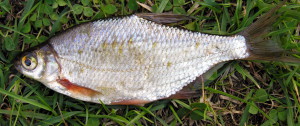 A species closely related to and resembling the common bream, still the silver bream has double-rowed pharyngeal teeth, larger scales and shorter anal fin (19-23 branched rays). The coloration is silvery, with gray unpaired fins, and red pectoral and pelvic fins, particularly at base. The Russian common name derives from the fact that in the spring and fall the fish form massive schools. Silver breams will grow 35 cm long and weigh 400 gr (in exceptional cases up to 1.2 kilos). They are found in rivers and lakes of Europe, in the basins of the North, Baltic, Black, Azov and Caspian Seas. The fish grows slowly, first spawning during year 3 or 4, being 12-14 cm long. Spawning happens in May or June. In rivers and the Ilmen’ Lake silver breams spawn intermittently, whereas in reservoirs they change over to single-batch. The single-batch spawning is observed with abundant forage. In lakes, reservoirs and rivers the silver bream keeps to bays with intense vegetation. Their diet is a mix of insect-larvae, mollusks and vegetation. The pharyngeal teeth in the species are rather strong, therefore in the Volga reservoirs mature silver breams feed on zebra mussels – they easily crush the strong shell of the mollusk (due to its morphology, the common bream cannot prey on zebra mussels). They are a secondary commercial fish of the Pskov-Peipsi Lake.
A species closely related to and resembling the common bream, still the silver bream has double-rowed pharyngeal teeth, larger scales and shorter anal fin (19-23 branched rays). The coloration is silvery, with gray unpaired fins, and red pectoral and pelvic fins, particularly at base. The Russian common name derives from the fact that in the spring and fall the fish form massive schools. Silver breams will grow 35 cm long and weigh 400 gr (in exceptional cases up to 1.2 kilos). They are found in rivers and lakes of Europe, in the basins of the North, Baltic, Black, Azov and Caspian Seas. The fish grows slowly, first spawning during year 3 or 4, being 12-14 cm long. Spawning happens in May or June. In rivers and the Ilmen’ Lake silver breams spawn intermittently, whereas in reservoirs they change over to single-batch. The single-batch spawning is observed with abundant forage. In lakes, reservoirs and rivers the silver bream keeps to bays with intense vegetation. Their diet is a mix of insect-larvae, mollusks and vegetation. The pharyngeal teeth in the species are rather strong, therefore in the Volga reservoirs mature silver breams feed on zebra mussels – they easily crush the strong shell of the mollusk (due to its morphology, the common bream cannot prey on zebra mussels). They are a secondary commercial fish of the Pskov-Peipsi Lake.
/ * The photos at lake.peipsi.org are cross-posted from commons.wikimedia.org and are used for familiarization purposes only. No commercial use of the photos is allowed. For more information about to use the photos see the originals on commons.wikimedia.org. /


